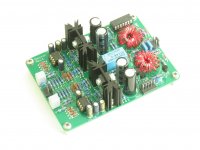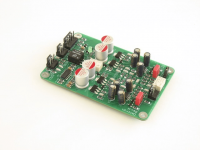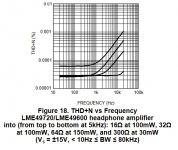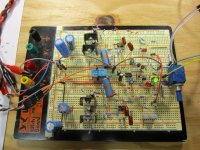

Omicron is:
- A compact, ultra-low distortion headphone amplifier that we developed jointly with @Rus2000 from the RCL-electro.ru forum
- Designed to work with 32 to 600 ohm headphones and tested with a range of over-the-ear and on-the-ear cans from AKG, Beyerdynamic, Grado, Klipsch, and Sennheiser but proved to be equally at ease with lower impedance 16 and 8 ohm headphones, such as AKG's K3003 3-way in-ear monitors; the ubiquitous white Apple EarPods (tethered ones, both 1st and 2nd generation) sound great with Omicron, too!
- Very musical, with pure, clean, liquid sound and perfect clarity even in the most harmonically complex pieces.
The sound immediately fascinated me so much that I began listening without adjusting the quiescent current. You want to turn up the volume, no mess, even the quietest sounds are clearly heard, but at the same time the sound is very comfortable, not harsh, a beautiful three-dimensional scene. Very nice bass. In short, top notch!
... sounds flawless and works equally well. [...] The claimed <140db probably holds true because this design sounds cleaner and smoother than anything ive built and that includes single opamp setups and well known discretes.
This amp is fantastic, I've been listening away and taking notes for a better review, spent a few hours last night playing games with it, worked wonderfully. It really blows all of my other headphone amps and line amps out of the water. The clarity is surreal.
Last night compared Omicron with my composite LT1210 based headamp. At first, it seemed that the LT1210 sounds softer and more beautiful, but after listening to Omicron for about an hour, I switched back and realized that now I want an Omicron for myself! With the same tonal balance, it gives an accurate, fast, assertive bass and better conveys space. Sounds great on good recordings.
Features:...the sound really is fantastic. [...] It's a huge step up from [...] bottlehead crack with the speedball upgrade.
The soundstage is really amazing with my hifiman cans and there's a wonderful amount of detail. Very liquid sounding and the amp just seems to do everything right. The amp runs very cold too, the case never even gets warm.
- Vanishingly low distortion: with THD and IMD better than -140dB (0.000 01% - that's only 100 parts-per-billion), Omicron is an order of magnitude more linear than other "high-performance" and "ultra-high performance" amplifiers
- Compact: Just one IC and two transistors per channel
- Inexpensive, commonly available parts (NE5532, BD139, BD140; just $42 at Mouser for the whole BOM)
- Easy through-hole construction (NEW: a smaller board with easy-to-hand-solder SMT parts has been developed, see its photo above)
- Functionally complete: One 80×110mm (60×90mm for the SMT version) board carries two amplifier channels, a sensitive DC protection for your headphones and an optional (switchable in the SMT version) cross-feed circuit, which helps create a realistic soundstage in headphones
IMD 19+20kHz, 5Vpp @32ohm (see post #11 for more measurements):
Theory of operation:
- Schematic design: post #2
- Mod: increasing input impedance: post #67 (this mod is now the stock version and part of the BOMs linked below)
- Loop gain (simulated): post #27
- Crossfeed schematic and frequency response: post #33
- DC protection: post #34
- Power supply: post #35
- Distortion, clip, frequency response: post #11
- Distortion and clip for the SMT version with no heatsinks and half the quiescent current: post #109
- Through hole Omicron board
- Schematic: post #295
- Board outline: post #142 - includes a discussion of how to fit Omicron into 1U enclosure
- Part list: post #155
- Winding the output inductor: post #71
- Mod: crossfeed switch board by @gajira: post #334
- SMT Omicron board
- Power supply board
- Assembly guide: post #225
- Choosing volume control: post #170
- Mod: running Omicron from +/-12V rails
Last edited:
I wanted a good sounding (of course!) headphone amplifier that would meet a few formal requirements:
- Distortion meaningfully - say by an order of magnitude - lower than that of a reasonable digital source, across the audio band.
- Suitable for headphones from 32ohm (i.e. Grados) to 600ohm (Beyerdynamic T1)
- At least 100mW of output power to deliver 120dB SPL peaks with the typical 100dB/mW headphones
- Stable with reasonable capacitive loads
- Common, easily available, inexpensive parts that will not disappear from the market tomorrow (or in a year)
- Usable without other boards - that is, cross-feed, fast DC protection and turn-on delay for headphones and EMI protection are all integrated on board
- Compact - doesn't need to fit into an Altoids can, but shouldn't be a full 17-inch box either
- Simple and easy to build, a comfortable weekend project
One can do compact with discrete SMT circuitry, but that would not be "simple and easy to build", hence Omicron is built with opamps.
Common, easily available, inexpensive opamps may or may not be able to drive 32ohm cans directly, so Omicron needs a current booster. An integrated high-speed buffer such as BUF634, LME49600 or LT1010 would do the job, but you can get 10 opamps for the price. So the booster is a classic push-pull emitter follower - just two transistors.
In a circuit like that, there are two major sources of distortion under designer's control. The obvious one is the output stage, where transistors experience large variations of voltage and current, leading to nonlinearity and to distortion. Since we only need 100mW - that's 80mA peak into 32ohm or 11V peak into 600ohm - and it is not a battery-powered headamp, Class A or AB with sufficient quiescent current is an easy choice. Unfortunately, even Class A by itself does not deliver the distortion we have in mind, so we will place it inside a feedback loop.
Quite a few headamps use a current booster inside the feedback loop of an opamp. It works well at low frequencies, below 1kHz or so, but at higher frequencies the opamp's gain goes down, and distortion goes up. This produces the familiar looking charts:

and familiar sound: feedback redistributes distortion to upper audio frequencies, adding brightness, making sibilants unnatural and muddling the midband with intermodulation products. We want to avoid this trap and push distortion below the noise level using more loop gain. So instead of a single opamp, Omicron uses two (two half of one dual) in each channel.
The other source of distortion is the opamp's input stage. Its has a delicate job of comparing a portion of the amplified signal with that from the source, and its own distortion is indistingushable from the useful signal. Better opamps may have more linear input stages, but are not necessarily common, easily available or inexpensive. Thankfully, there is another way. Increasing the loop gain (which we need anyway) decreases the differential input voltage that the input stage sees, making its job easier and distortion - smaller.
That was for the differential component of the input voltage, but there is also the common mode component. In a typical non-inverting configuration, the differential voltage may be zero, but inverting and non-inverting inputs would be flying up and down with the full amplitude of the input signal. This generates measurable and audible distortion, which we want to avoid. So Omicron is an inverting amplifier.
Inverting, of course, reverses the absolute phase. There are many people who say they can hear absolute phase, and prove this by flipping the phase switch on their amp or reversing speaker connection. However, this is not a blind test and can be (and probably is) biased. A more subtle test was offered by Stereophile on their first Test CD:


Common, easily available, inexpensive opamps may or may not be able to drive 32ohm cans directly, so Omicron needs a current booster. An integrated high-speed buffer such as BUF634, LME49600 or LT1010 would do the job, but you can get 10 opamps for the price. So the booster is a classic push-pull emitter follower - just two transistors.
In a circuit like that, there are two major sources of distortion under designer's control. The obvious one is the output stage, where transistors experience large variations of voltage and current, leading to nonlinearity and to distortion. Since we only need 100mW - that's 80mA peak into 32ohm or 11V peak into 600ohm - and it is not a battery-powered headamp, Class A or AB with sufficient quiescent current is an easy choice. Unfortunately, even Class A by itself does not deliver the distortion we have in mind, so we will place it inside a feedback loop.
Quite a few headamps use a current booster inside the feedback loop of an opamp. It works well at low frequencies, below 1kHz or so, but at higher frequencies the opamp's gain goes down, and distortion goes up. This produces the familiar looking charts:

and familiar sound: feedback redistributes distortion to upper audio frequencies, adding brightness, making sibilants unnatural and muddling the midband with intermodulation products. We want to avoid this trap and push distortion below the noise level using more loop gain. So instead of a single opamp, Omicron uses two (two half of one dual) in each channel.
The other source of distortion is the opamp's input stage. Its has a delicate job of comparing a portion of the amplified signal with that from the source, and its own distortion is indistingushable from the useful signal. Better opamps may have more linear input stages, but are not necessarily common, easily available or inexpensive. Thankfully, there is another way. Increasing the loop gain (which we need anyway) decreases the differential input voltage that the input stage sees, making its job easier and distortion - smaller.
That was for the differential component of the input voltage, but there is also the common mode component. In a typical non-inverting configuration, the differential voltage may be zero, but inverting and non-inverting inputs would be flying up and down with the full amplitude of the input signal. This generates measurable and audible distortion, which we want to avoid. So Omicron is an inverting amplifier.
Inverting, of course, reverses the absolute phase. There are many people who say they can hear absolute phase, and prove this by flipping the phase switch on their amp or reversing speaker connection. However, this is not a blind test and can be (and probably is) biased. A more subtle test was offered by Stereophile on their first Test CD:
If you believe that absolute phase is important, get the CD and listen to the track and find where the change in polarity occurs. If you can do it, then you may want to rewire your headphonesTrack 8 on the CD features an "absolute phase" demonstration. The sound starts out with its overall polarity one way around, but finishes with its polarity inverted. According to many writers, especially Clark Johnsen in his book The Wood Effect, the sound of human voice and many instruments will be more natural with the polarity correct—ie, so that an acoustic compression that reaches the microphone will be reproduced as an acoustic compression that reaches the listener's ear—than it will the other way. We have no idea which way 'round on Gordon's recording is correct, but as we have inverted the polarity somewhere in the middle, you will be able to hear for yourself if there is an audible difference between the two states. And can you identify where the change in polarity occurs?
Actual amplifier schematic (one channel shown):
Each channel of Omicron is a composite amplifier built with two halves of an NE5532 and a two-transistor complementary emitter follower (EF) as a current booster. There are two feedback loops - one global and one for the second opamp and the EF. This configuration was selected after comparing a number of alternatives, including a single opamp with a current booster, a Yewen style composite, a Samuel-Groner-super-opamp-style composite, and a few others.
- R1R3R5C1C2 is the global feedback loop.
- R1C1 is the input LPF. The amplifier is relatively wideband, with -3dB point of its frequency response at several 100's kHz (measurements will follow).
- C2 provides lead compensation, improving phase margin.
- D3-D6 and R10 adjust the loop gain in case of clipping or slewing, helping recovery.
- R7R8R9C4C5C6 is a local feedback loop with two-pole compensation.
- Q1Q2 and associated parts are the output current booster. R13 and R14 set the quiescent current, D7 and D8 provide thermal compensation.
Gain is x2.5, which works for both low- and high-impedance headphones. Input impedance is relatively low at 2kOhm - modern sources will handle it easily. The amplifier does not include a volume control in order not to be tied to a specific part; a 10kOhm pot with linear characteristic can be used - together with the input impedance and the effect on gain, it produces a control characteristic which is closer to true logarithmic than many audio pots.
Simulation results, actual performance measurements, the DC protection schematic and construction details will follow.
Last edited:
It's not so linear - or should I say logarithmic? There is a qualitative change in sound that comes with improved linearity.I bet this will sound 20 db better
Make better headphones, of courseNow what do we do about the best current headphones distortions

Are you sure we're way better than our ancestors due to technology improvement? Do we see or hear better? Do we breathe better, do we sleep remarkably better, do we get laid more often?Humanity never got anywhere by sitting happy with current technology
YesAre you sure we're way better than our ancestors due to technology improvement? Do we see or hear better? Do we breathe better, do we sleep remarkably better, do we get laid more often?
At 1kHz, maybe. Most SS headamps claim to have low distortion, but in reality there are not many out there with distortion actually measured low across the audio band. Make sure you have heard one of those before having opinions.I think I built enough headphones amps to know how irrelevant these ultralow harmonic distortions figures are...
Before we drift off to a discussion suitable for The Lounge, here are some (pretty boring) measurements:
THD 1kHz, 5Vpp @32ohm:
IMD 19+20kHz 1:1, 5Vpp @32ohm:
SMPTE 60Hz+7kHz 4:1, 5Vpp @32ohm:
IMD 1+5.5kHz 1:1 (proposed by Siegfried Linkwitz because its intermodulation products fall into the frequency range where the human ear is most sensitive):
You can get a little more interesting pictures with a much higher output level into a low impedance load, where the limitations of the simple output stage show up. Here is 16Vpp into 32 ohm - that's 2 watts of peak power that would likely damage your hearing 🦻 and/or set the headphones on fire 🔥. Omicron is not designed for this, but nothing terrible happens, it is still very linear:
Omicron clips cleanly:
and doesn't squirm at fast square waves:
As stated above, Omicron is rather wideband and will not twist phase in the audio band:
Last edited:
The design goal was at least 100mW into loads from 32 to 600ohm - with the typical cans' sensitivity of 100dB/mW that gives 120dB SPL. In reality, with +/-17V rails it swings 30Vpp at the output, with the current limited by the output stage's SOA. I tested it at 1Wrms @ 32ohm, and it works fine with some increase in distortion vs. 100mW, see the measurements above. Never tested it with 8ohm - IMO a pair of TO-126 transistors on a board-level heatsink is not an adeqate output stage for that kind of load.What output does it have into 8R, 32R, 250R and 600R?
An output stage like this, without the feedback loop, has a rather high and non-linear output impedance - see my last year's posts on modding the KSA-5 clone. It is not that important with higher impedance loads, because in the divider formed by the output impedance and the load, the output impedance is small. With the low impedance load, the nonlinearity rears its ugly head. Feedback will help, of course, but the distortion performance will not be the same.I'd imagine it'll do fine into the normal IEM 8-ohm load, those barely need any power. Not sure why one would want to use this with serious 8-ohm speaker loads though...
BTW the modded KSA-5 works nicely with speakers
I've sometimes wondered about producing a speaker power amp where an opamp is used for the negative feedback loop just like this. I assumed it was too simple to work or everyone would do it. Is there a reason this can not be scaled up with more powerful transistors and work just as well?
- Home
- Amplifiers
- Headphone Systems
- Omicron, a compact headphone amp with -140dB distortion